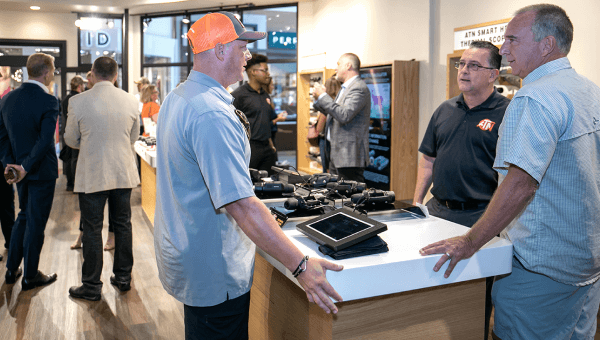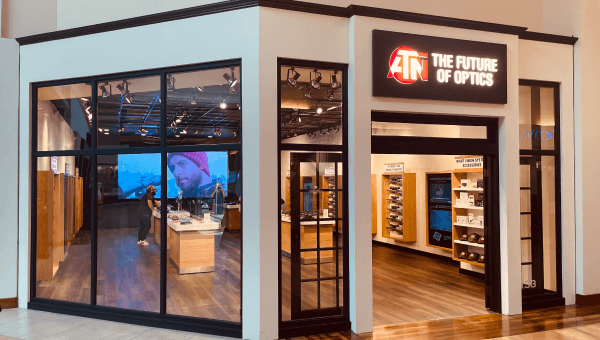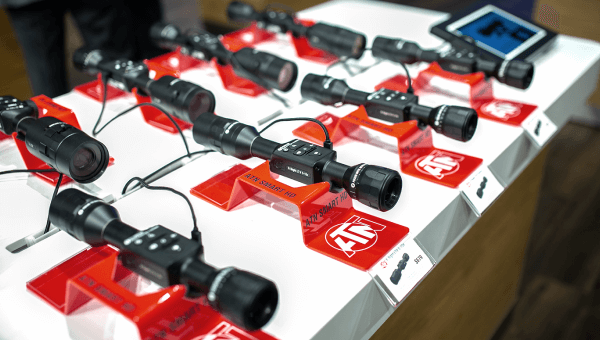Night Vision Terminology
American Technologies Network Corporation Manufactures and Distributes the widest array of Night Vision Equipment in the world. With over 150 models to choose from in Night Vision, Day/Night Scopes or state-of-the-art Day Time Riflescopes ATN got you cover 24/7. For Pro or novices alike you will find the best whether you are looking for Night Vision Monoculars, Night Vision Goggles, Night Vision Binoculars, Night Vision Weapon Sights, advanced Day/Night Vision Systems.
Descriptions and Specifications of all Night Vision Equipment contain many special Night Vision terms. Here we show the description of most often used terms.
OPTICAL EQUIPMENT TERMINOLOGY
Magnification - Is simply the degree to which the object is enlarged. With a 7×35 binocular, for example, the object appears to be seven times closer than without the aid of a binocular. The number immediately following the ‘×’ is the diameter in millimeters of the objective (front) lens. A 10×50 binocular, therefore, has a 10 times magnification with a 50 mm objective lens.
Field of View (FOV) - The field of view is the width, measured in degrees or feet, of the viewing area you would see at 1,000 yards.
Bright Source or Over-Light Protection - An electronic circuit that turns the power to the night vision device down or off when it is exposed to bright light (such as automobile headlights). This protects the image intensifier and extends its life. The device will revocer and resume normal operation in 1—2 minutes.
EyePiece Focus - Used to match your night vision scope or binocular to your specific eyesight.
Image Intensifier Or Intensifier Tube - The active component in a night vision system that amplifies light and presents a usable image.
Infrared (IR) Illuminator - Provides a light source for the system to amplify, yielding enhanced images in very low light conditions such as caves where no ambient light is available for amplification.
Objective Lens - Collects all available light and focuses it on the image intensifier. It also provides image magnification.
Phosphor Screen - Positioned at the back of the intensifier tube, the green phosphor screen renders a visible night vision image. The human eye is most sensitive to green contrasts.
Photocathode - Converts light (photon energy) into electrons (electrical energy) which are then amplified in the intensifier. The objective lens focuses available light on the photoelectric surface of the photocathode, which is excited and passes electrons within the tube.
Resolution - A measure of the ability to render and display a detailed image. Image intensifier resolution remains constant and is expressed as the maximum number of line pairs per millimeter (LP/MM) that can be discerned when a black-and-white stripe pattern is focused on the photocathode.
Exit Pupil - The exit pupil refers to the size of the shaft of light transmitted to the eye. The more light, the better the contrast. You can actually see the exit pupil by holding the eyepiece of the binocular approximately 12 inches from your eye. It is the bright circle of light in the center of the eyepiece. Exit pupil is expressed in millimeters and is normally derived by dividing the power into the objective lens diameter. A 7×35 binocular has an exit pupil of 5 mm.
Prism Systems - Binoculars have left and right side barrels linked to each other by an axle. The two most frequently used prism systems are porro and roof. Porro Prism binoculars are characterized by the eyepieces being offset from the objective lenses. Roof Prism binoculars feature lenses positioned in line for a more compact design.
Coated Optics - Optical glass surfaces are coated by magnesium fluoride to reduce light loss and glare due to reflection. Most binoculars are fully multi-coated to further enhance viewing and reduce eye strain. Some binoculars have a special image enhancing, amber, high contrast coatings.
WaterProof - This describes a binocular's ability to remain completely dry on the inside when exposed to moisture or total submersion in water. Binoculars are sealed with O-rings and are filled with 100% arid nitrogen, which also resists all forms of moisture.
Stray Light - When light entering the binoculars reflects off of interior surfaces, the reflected light eventually exits inside the binoculars in the form of stray light. This unfocused light typically diminishes the image quality of the sight picture.
Focusing Range - All binoculars have the ability to be focused for infinity. So a primary point of distinction between binocular models is the minimum focus range. Birders tend to favor models with a short focus range of about 15 feet, but 20 to 25 feet is usually acceptable.
Twilight Performance - Using the below formulas gives a basic evaluation of low light performance, however, one must keep in mind that they are mathematical formulas and do not take into effect some of the most critical features in optics: glass quality, number of lenses, precision of manufacturing and coatings.
SPOTTING SCOPE TERMINOLOGY
The spotting scope you choose greatly affects how it will work for you under certain conditions. For example, the person who only wants to use his or her spotting scope at the rifle range can often drive up to the bench and conveniently layout supplies including a large objective porro prism spotting scope. The target shooter could easily use a 80 mm porro prism scope on a full-length tripod and not worry about compact design or lightweight since their automobile is a few yards away. On the other hand, a person who is planning an elk hunt is probably very concerned with weight and the ability to fit the scope into a pack.
Typically roof prism spotting scopes offer the hunter or backpacker a more compact and lightweight design to pack and carry long distances. While some porro prism spotting scopes are quite compact, others can offer larger fields of view and resolution, but they may not be practical to pack into the woods. Other features for the hunter to consider are rubber armoring to protect the scope from blunt force. A waterproof spotting scope offers piece of mind to the hunter working in rain and snow. This is not a comprehensive list of all the factors to consider when choosing a spotting scope but it will hopefully shed some light on some of the more critical factors to consider.
Magnification - The magnification feature of a spotting scope allows the user to view an object much closer than it would otherwise be using only the human eye. The magnification power is a function of both the scope's optical system and the eyepiece being used.
Objective Lens Diameter - The objective lens of a spotting scope serves to gather incoming light. A 60 mm objective lens will gather more light than a 50 mm lens. When more light is transmitted to your eye, you will view a brighter and clearer image. Resolution (ability to see detail) is also a function of the objective lens diameter.
Eye Relief - Eye relief is the minimum distance between the spotting scope eyepiece and your eye that still allows you to see the entire field of view. Hunters and shooters who do not wear eyeglasses can use most spotting scopes and eyepieces without any trouble. People who wear eyeglasses are more concerned with eye relief. When a person wears glasses while looking through a standard spotting scope eyepiece their glasses may touch the eyepiece. The need for eye relief is an individual specific need. Sometimes eyeglass wearers are more comfortable looking through a spotting scope without their glasses on.
Optical Lens Coatings - Lens coatings play an important role in getting the light gathered at the objective end of the scope transmitted through the ocular end to your eye. The lens coatings are partially responsible for delivering a brighter and higher contrast image.






